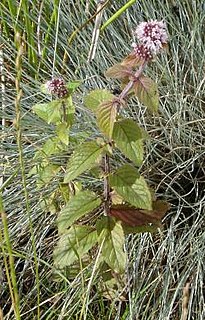
Mentha aquatica is a perennial flowering plant in the mint family Lamiaceae. It grows in moist places and is native to much of Europe, northwest Africa and southwest Asia.

Rumex obtusifolius, commonly known as bitter dock, broad-leaved dock, bluntleaf dock, dock leaf or butter dock, is a perennial plant in the family Polygonaceae. It is native to Europe, but is found on all temperate continents. It is a highly invasive species in some zones, resulting from its abundant seed dispersal, adaptability to reproduce, aggressive roots, ability to tolerate extreme climates, and hardiness.

Cornus sanguinea, the common dogwood or bloody dogwood, is a species of dogwood native to most of Europe and western Asia, from England and central Scotland east to the Caspian Sea. It is widely grown as an ornamental plant.

Campanula latifolia, the giant bellflower, is a species of bellflower in the family Campanulaceae. It is also known as the large campanula and the wide-leaved bellflower. It is native to Europe and western Asia and is widely grown as an ornamental plant.

Veronica arvensis, common names: wall speedwell, corn speedwell, common speedwell, rock speedwell, field speedwell, is an annual flowering plant in the plantain family Plantaginaceae. The species is a native European plant and a common weed in gardens, pastures, waste places and cultivated land.

Cassine laneana, commonly known as the Bermuda olivewood, is a species of large tree in the staff vine family, Celastraceae, that is endemic to the islands of Bermuda. Although once found in the extensive subtropical coniferous forests that covered the islands, it is currently restricted to small protected areas, such as Spittal Pond. C. laneana can grow anywhere from 25 to 40 feet tall, with leaves that are 1 to 2.5 inches long and 0.5 to 1.5 inches wide. The leaves are also a deep green colour when they are older and a bright green colour when they are younger. C. laneana flowers in late spring and early summer and produces a small ovate berry that is an olive colour and 0.25 to 0.5 inches long.

Vincetoxicum hirundinaria, commonly named white swallow-wort, is a long-lived herbaceous perennial of the genus Vincetoxicum in the family Apocynaceae.

Sagina saginoides is a species of flowering plant in the family Caryophyllaceae known by the common names arctic pearlwort or alpine pearlwort. It has a circumboreal distribution; it can be found throughout the northern latitudes of the Northern Hemisphere. It grows in subalpine and alpine climates and other mountainous habitat at lower elevations. This is a small perennial herb producing a slender to threadlike stem just a few centimetres long, growing decumbent or erect. It is sometimes clumpy in form. The leaves are linear in shape and about 1 to 2 centimetres in length. The inflorescence is a solitary flower with five sepals and five small white petals.
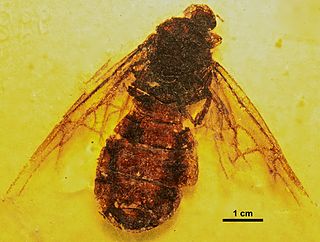
Titanomyrma is a genus of prehistoric giant ant. The latest species to be discovered, T. lubei, was described in 2011, when a 49.5-million-year-old fossilized winged queen ant, comparable in size to hummingbirds, was found in Wyoming, United States. This fossil is the first fossil of a giant ant found in the Western Hemisphere. The presence of Titanomyrma in North America is considered to indicate "the first reported cross-Arctic dispersal by a thermophilic insect group". Another fossil species of this genus, T. gigantea, is the largest-known fossil or extant species of giant ant in the world.
Lippia substrigosa is a plant from the family Verbenaceae that is native to Central and South America. It can grow as either a shrub or a tree up to 7 metres (23 ft) tall and can be burned to produce fuel. Its essential oil may have pharmaceutical or cosmetic uses.
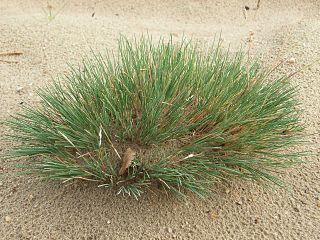
Corynephorus canescens, common name grey hair-grass or gray clubawn grass, is a species of plants in the grass family, native to Europe, the Middle East, and North Africa but widely naturalized in North America. In the United Kingdom it is rare. It can be found at sites such as Wangford Warren and Carr, a Site of Special Scientific Interest in the Breckland area of Suffolk.
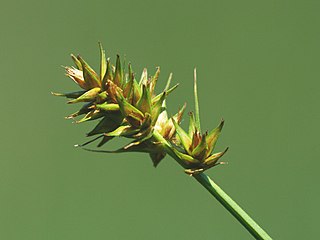
Carex otrubae, the false fox-sedge, is a species of flowering plant in the sedge family, Cyperaceae.

Oplismenus compositus, the running mountaingrass, is a species of perennial plant from the family Poaceae that can be found throughout Asia, Africa, Australia, South America, Mexico and Hawaii.
Oplismenus thwaitesii is a flowering plant that is endemic to India.

Sesleria albicans is a species of perennial grass in the family Poaceae which can be found throughout Europe.

Hakea hastata is a shrub in the family Proteaceae and is endemic to southern Western Australia. It is an open, upright shrub with light green leaves, branches covered in dense hairs and white flowers in spring.

Austrocylindropuntia subulata is a species of cactus native to the Peruvian Andes. The Latin specific epithet subulata means "awl-like", referring to the shape of the rudimentary leaves. It is also known by its common names as Eve's pin and Eve's needle.
Citrus platymamma, called byeonggyul in Korean and benjul in Jeju, is a Korean citrus fruit native to Jeju Island.
Primula tanneri is a species of flowering plant in the family Primulaceae.
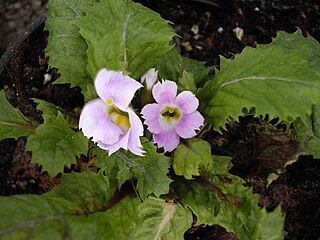
Primula bracteosa, the orange throated primrose, is a perennial species of primrose which is found on rocky crevices and of ravines at the altitudes of 2,300–2,700 metres (7,500–8,900 ft) in southern Xizhang, Bhutan, northeast India, Sikkim and Nepal.
















